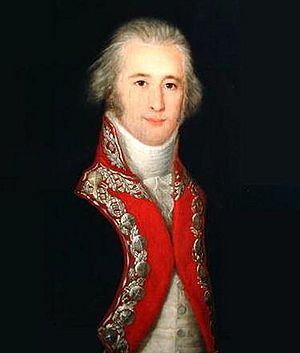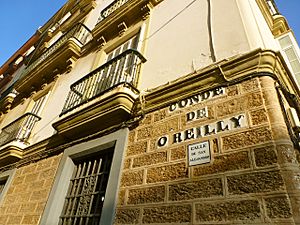Alejandro O'Reilly facts for kids
Quick facts for kids
The Most Excellent
The Count of O'Reilly
|
|
|---|---|

Portrait by Francisco Goya
|
|
| 3rd Spanish Governor of Louisiana | |
| In office April 1769 – December 1769 |
|
| Monarch | Charles III |
| Preceded by | Charles Philippe Aubry Acting |
| Succeeded by | Luis de Unzaga |
| Personal details | |
| Born |
Alexander O'Reilly
October 24, 1723 Baltrasna, County Meath, Ireland |
| Died | March 23, 1794 (aged 70–71) Cádiz, Spain |
| Resting place | Bonete, Spain |
| Spouse | Rosa de Las Casas |
| Nickname | Bloody O'Reilly |
| Military service | |
| Allegiance | |
| Branch/service | Spanish Army |
| Rank | Marshal of Spain |
| Battles/wars | War of the Austrian Succession Seven Years' War Louisiana Rebellion Invasion of Algiers French Revolutionary Wars |
Alejandro O'Reilly, also known as the 1st Count of O'Reilly, was an important military leader. He was born in Ireland on October 24, 1723. He became a high-ranking officer in the Spanish Army.
O'Reilly was known for making big changes to the Spanish military. He served as the second Spanish governor of Louisiana. This was after France gave the territory to Spain. Because of his great service, the King of Spain made him a conde (Count). He was given the title "Count of O'Reilly."
Contents
Early Life and Military Career
Joining the Spanish Army
Alexander O'Reilly was born in Baltrasna, County Meath, Ireland, in 1723. His family had a history of military service. His grandfather, John Reyly, was a colonel in the army. Many Irish people, like O'Reilly, left Ireland to serve in other countries' armies. They were sometimes called "Wild Geese."
O'Reilly joined the Spanish forces. He fought against the Austrians in Italy. He swore loyalty to Spain and quickly moved up in rank. He became a brigadier general.
Reforming Defenses in Cuba and Puerto Rico
O'Reilly worked with the Conde de Ricla in Havana, Cuba. He was Ricla's assistant and second-in-command. They helped get Havana back from the British. The British had captured the city during the Seven Years' War.
O'Reilly studied why Cuba's defenses failed. He suggested many changes to improve the forts and army training. The King of Spain quickly approved his ideas. A large fortress called La Cabaña was built based on his plans.
In 1765, King Charles III sent O'Reilly to Puerto Rico. His job was to check the island's defenses. O'Reilly is sometimes called the "father of the Puerto Rican militia." He counted everyone on the island. He also suggested many improvements for the local troops. He made sure soldiers were paid fairly and directly. Some of his ideas led to a 20-year project. This project built up the Castle of Old San Juan. Today, this castle is a World Heritage Site.
Family Connections
After returning to Cuba, O'Reilly married Rosa de Las Casas. Her family was very well-known in Cuba. Her brother, Luis de Las Casas, later became the governor of Cuba.
O'Reilly was also related to other important people. He was the uncle of Juan MacKenna. Juan MacKenna was a hero in the Chilean War of Independence. He was also a cousin of Hugo Oconór. Hugo Oconór founded Tucson, Arizona. He also served as governor of Spanish Texas.
Governor of Louisiana
Putting Down a Rebellion
In April 1769, O'Reilly was made Governor of Spanish Louisiana. He was ordered to go to Havana. From there, he would take 3,000 soldiers to Louisiana. His mission was to stop a rebellion and bring back order. Some French colonists in Louisiana had forced out the first Spanish governor.
O'Reilly arrived in New Orleans in August 1769. He officially took control of Louisiana. He held trials for the French colonists who had rebelled. He punished those responsible for expelling the first governor. In New Orleans, some people called him "Bloody O'Reilly." This was because he had six rebel leaders executed in October 1769. Other rebels were sent away or imprisoned in Morro Castle in Havana.
Organizing the Colony
After stopping the rebellion, O'Reilly sent most of his soldiers back to Cuba. He focused on setting up Louisiana's government. He also worked to make sure there was enough food. Before, Louisiana had to import grains from other French settlements.
O'Reilly changed many French rules that were still in place. Just like in Puerto Rico, his decisions affected many parts of life in Louisiana. He allowed enslaved people to buy their freedom. He also made it easier for slave owners to free their slaves. He stopped the trade of Native American slaves. He also ended Native American slavery.
He made sure that weights and measurements were the same in all markets. He also regulated doctors and surgeons. He improved public safety by funding repairs for bridges and levees.
In December 1769, O'Reilly appointed a new governor for Louisiana. He himself kept the higher position of Captain-General. This made Louisiana a clear dependency of the Spanish military and government in Cuba.
Later Years and Legacy

After October 1770, O'Reilly returned to Spain. He was tasked with creating six new army regiments. These regiments were to be trained near Cádiz. They would be ready to go to the Caribbean if Spain and Great Britain went to war again.
In 1775, O'Reilly led a large Spanish attack on Algiers. This campaign in North Africa was not successful. However, O'Reilly's good reputation was not ruined. He continued to serve as a captain-general in southern Spain.
Alejandro O'Reilly died in Cádiz, Spain, in 1794. He was 70 years old. He was on his way to lead an army against French revolutionary forces. He is buried in a church in Bonete, Spain. Streets in Cádiz and Old Havana, Cuba, are named after him.
See also
 In Spanish: Alejandro O'Reilly para niños
In Spanish: Alejandro O'Reilly para niños
- Military history of Puerto Rico
- Irish military diaspora
- Irish regiments
- Demetrio O'Daly

